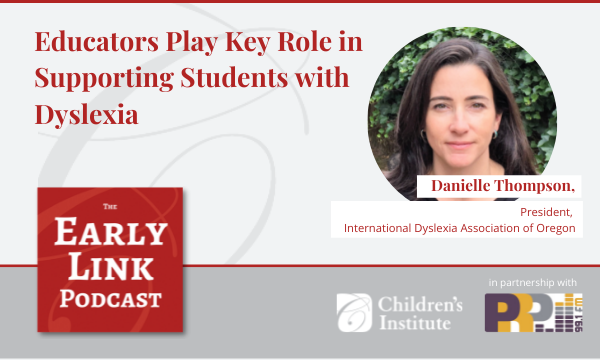On this episode of The Early Link Podcast, host Rafael Otto speaks with Danielle Thompson, who is the president on the board of directors for the Oregon branch of the International Dyslexia Association. She has been an educator for more than two decades. And as a dyslexia screener and tutor, she has been on a journey to understand the impact of dyslexia on students and how educators can do more to help.
Summary:
Throughout the episode, Danielle covers the different aspects of dyslexia. She first walks us through the definition of dyslexia as, “characterized by difficulties with accurate and or fluent word recognition and poor spelling and poor decoding abilities.” This can be taken a step further and even influence the processing of sound. She then follows up that there are plenty of misconceptions about children with dyslexia – the most common one being that dyslexics see words backwards. Another aspect Danielle clears up is that it’s a neurobiological condition that is not correlated to one’s intelligence.
Danielle also discusses the “continuum of severity” for dyslexia, and how some students are able to mask dyslexic traits while others are not. Then, the prevalence of dyslexia in Oregon is touched on, as well as what needs to change in the education system to properly teach those with dyslexia. The primary way to address this is through screening processes.
Finally, she provides resources for parents, educators, professionals, and those interested in finding out more about dyslexia, the screening processes, etc.
Additional Resources:
International Dyslexia Association – Oregon
Transcript
Rafael Otto: [00:00:00] This is the Early Link Podcast. I’m your host Rafael Otto. Today, I have the pleasure of speaking with Danielle Thompson, who is the president on the board of directors for the Oregon branch of the International Dyslexia Association. She has been an educator for more than two decades and as a dyslexia screener and tutor, she has been on a journey to understand the impact of dyslexia on students and how educators can do more to help.
Danielle, welcome to the podcast.
Danielle Thompson: [00:00:25] Thank you. It’s a pleasure to be here.
Rafael Otto: [00:00:26] Great to have you. So start us off by talking about dyslexia, what it is, how we define it.
Danielle Thompson: [00:00:32] All right. Well, dyslexia is a specific learning difference or a specific learning disability and it’s neurobiological in origin. We can see the learning differences in the brain. And it’s characterized by difficulties with accurate and/or fluent word recognition and poor spelling and poor decoding abilities.
And then those difficulties can typically result from a deficit in the phonological or the sound component of language. And it’s often unexpected relative to other strengths that a person might show. And then secondary difficulties that can come along with dyslexia can be like, limited reading exposure, and then a lower vocabulary development and difficulties with comprehension. Dyslexia occurs across like all backgrounds and all cultures all around the world, and it can be diagnosed. But many people have symptoms or characteristics of dyslexia and are not diagnosed, because it can range from mild to severe, to profound.
Rafael Otto: [00:01:40] What are some of the misconceptions about dyslexia and how it shows up in students?
Danielle Thompson: [00:01:45] The most common one I’ve heard is that people think that dyslexia is seeing things backwards and there’s no, um, difficulty in terms of how a person with dyslexia sees the printed page or the printed screen. But the challenge for students with dyslexia or adults with dyslexia comes from the way that their brain processes language. And scientists can see from FMRIs there’s a different neural signature for people with dyslexia when asked to do language related tasks or in general, perhaps a different brain organization. So they use different pathways to process language and it can take longer and it can make it more difficult. But seeing things backwards is a most common myth. The fact that it might occur more in one gender than the other is another myth. It’s generally pretty equally found across genders.
Rafael Otto: [00:02:37] Okay.
Danielle Thompson: [00:02:38] And it’s not for a lack of instruction or an early exposure to a print rich environment. It’s not due to poor parenting.
Rafael Otto: [00:02:49] Right. This is a neuro-biological condition that, that people are dealing with, right?
Danielle Thompson: [00:02:53] Yes, and it’s not related or tied to intelligence.
Rafael Otto: [00:02:57] Can it manifest later in life or is it typically something someone is born with?
Danielle Thompson: [00:03:03] You’re born with your brain working in certain ways that scientists have later determined. If your brain sort of has this structure, or responds to speech sounds milliseconds slower, that those students go on to then have reading difficulties. But many people, if they’re not severe enough, might mask that they have this learning difference or learning disability.
Please download the full transcript below.

